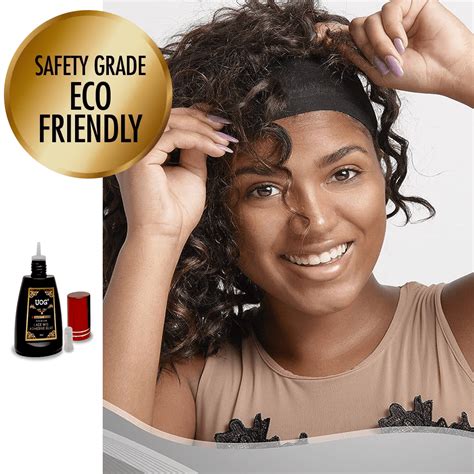Lace wigs have gained immense popularity due to their natural appearance and versatility. However, securing a lace wig effectively requires reliable adhesives, commonly known as lace wig glues. This comprehensive guide delves into the intricate world of lace wig glue, empowering readers with the knowledge and techniques to achieve flawless applications.

Understanding Lace Wig Glue
Lace wig glue is a type of adhesive specifically designed to bond lace wigs to the scalp. It is typically formulated with ingredients that create a strong, long-lasting hold while minimizing irritation or damage to the natural hair.
Types of Lace Wig Glue
Numerous types of lace wig glues exist, each catering to specific preferences and requirements. Common types include:
- Alcohol-based glues: Provide quick drying and strong hold but can irritate sensitive skin.
- Water-based glues: Offer a gentler option, less likely to cause irritation, but may have a weaker hold.
- Medical-grade glues: Designed for sensitive skin, providing a secure hold with minimal risk of irritation.
- Bonding adhesives: Ultra-strong glues used for extended wear, requiring special solvents for removal.
Choosing the Right Lace Wig Glue
Selecting the ideal lace wig glue depends on several factors:
- Skin sensitivity: Choose water-based or medical-grade glues for sensitive skin.
- Desired hold: Alcohol-based and bonding adhesives provide a stronger hold for longer wear.
- Application preference: Consider the ease of application, drying time, and removal process.
Step-by-Step Lace Wig Application with Glue
- Prepare the scalp: Cleanse and dry the scalp thoroughly. Apply a thin layer of scalp protector to minimize irritation.
- Apply glue to the wig’s hairline: Use a thin brush or cotton swab to apply a small amount of glue to the wig’s hairline.
- Position the wig: Align the wig on the hairline and gently press it down. Use a Wig Cap or Stocking Cap for added security.
- Secure the wig: Once the wig is positioned, hold it in place for several minutes to allow the glue to set.
- Remove excess glue: Use a cotton swab dipped in glue remover to gently remove any excess glue from the hairline.
Why Lace Wig Glue Matters
Choosing the right lace wig glue is crucial for several reasons:
- Security: A secure glue ensures the wig stays in place, preventing embarrassment or wardrobe malfunctions.
- Comfort: Properly applied glue minimizes irritation or damage to the natural hair, promoting comfort during wear.
- Durability: High-quality glue can withstand sweat, heat, and movement, extending the wig’s lifespan.
Health and Safety Considerations
While lace wig glues are generally safe for use, it is essential to prioritize health and safety when using these adhesives:
- Avoid over-application: Excessive glue application can clog hair follicles, leading to scalp irritation or hair loss.
- Use glue remover cautiously: Some glue removers can be harsh on the skin. Test the remover on a small area before using it near the hairline.
- Avoid prolonged wear: Remove the wig and cleanse the scalp regularly to prevent buildup or irritation.
Creative Applications for Lace Wig Glue
Beyond lace wig applications, lace wig glue offers innovative possibilities in various industries:
- Medical: Bonding dressings or bandages to sensitive skin
- Fashion: Adhering embellishments to clothing or accessories
- DIY projects: Crafting custom home décor or accessories
Useful Tables
Table 1: Types of Lace Wig Glue
| Glue Type | Advantages | Disadvantages |
|---|---|---|
| Alcohol-based | Strong hold, quick drying | Irritating to sensitive skin |
| Water-based | Gentle on skin, less likely to irritate | Weaker hold |
| Medical-grade | Hypoallergenic, strong hold | Expensive |
| Bonding adhesives | Ultra-strong hold, long-lasting | Difficult to remove, requires special solvents |
Table 2: Lace Wig Glue Application Timelines
| Glue Type | Drying Time | Hold Time |
|---|---|---|
| Alcohol-based | 1-2 minutes | 2-4 hours |
| Water-based | 5-10 minutes | 1-2 hours |
| Medical-grade | 10-15 minutes | 3-6 hours |
| Bonding adhesives | 20-30 minutes | 8-12 hours |
Table 3: Lace Wig Glue for Different Hair Types
| Hair Type | Recommended Glue Type |
|---|---|
| Fine hair | Water-based or medical-grade |
| Thick hair | Alcohol-based or bonding adhesives |
| Damaged hair | Medical-grade |
| Sensitive scalp | Water-based or medical-grade |
Table 4: Tips and Tricks for Lace Wig Application
| Tip | Benefit |
|---|---|
| Use a lace wig cap or stocking cap | Ensures a snug fit and minimizes movement |
| Apply glue to the wig’s nape first | Prevents glue from dripping on the forehead |
| Hold the wig in place with a clamp or clips | Maintains alignment while the glue sets |
| Avoid touching the hairline | Prevents glue from smudging or clumping |
| Use a fan to accelerate drying time | Shortens waiting period before wearing the wig |
Conclusion
Lace wig glue plays a pivotal role in achieving flawless, secure lace wig applications. By understanding the different types, choosing the right glue for individual needs, and following proper application techniques, wig wearers can confidently achieve a natural and seamless look. Remember to prioritize health and safety considerations, and explore the creative possibilities beyond lace wig applications. Embrace the transformative power of lace wig glue and elevate your wig-wearing experience to new heights.
